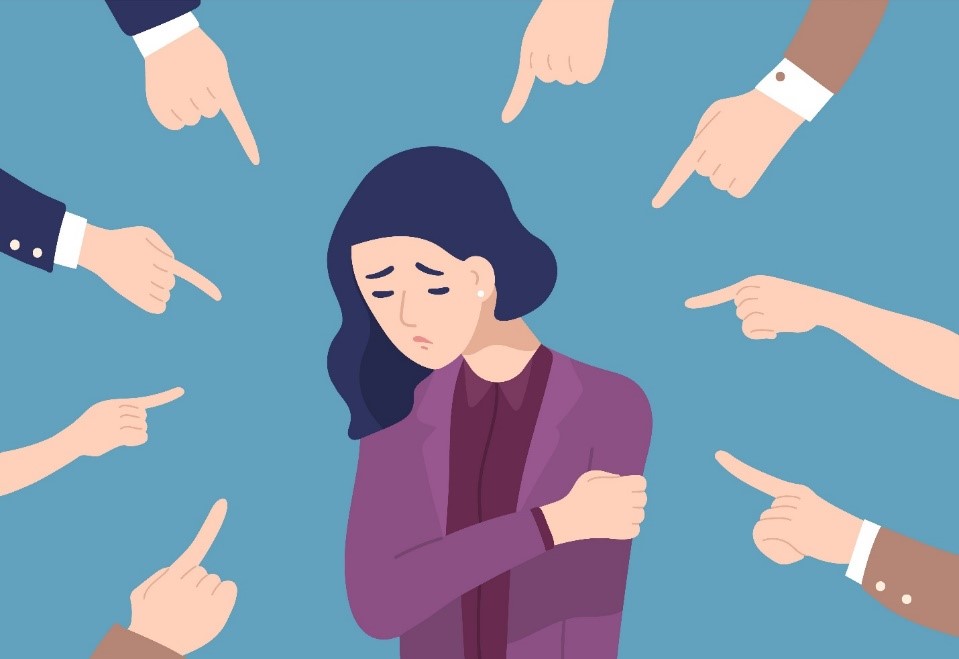Substance Use Services Blog Series: Different Kinds of Stigma, Shame, and Self-Compassion
June 18, 2020
Last week’s post introduced the concept of stigma. This week, we’ll be expanding on that topic by examining three different types of stigma and then exploring self-compassion as a means of coping with shame and self-stigma.
Different types of stigma
The Government of Canada website breaks stigma down into three categories: social, structural, and self-stigma[1]. The website also provides examples of how each kind of stigma may be perpetrated against people who use drugs.
Social Stigma: Examples of social stigma from the Government of Canada website include:
- negative attitudes towards people who use drugs or towards their friends and family members
- the use of negative labels in everyday conversation and in the media
- the use of negative images of people who use drugs or of their families
- ignoring people with a substance use disorder or ignoring their families[2]
Structural Stigma: The next category of stigma, structural stigma, commonly refers to how institutions (like the health care system, education system, or criminal justice system) contribute to and/or reinforce negative beliefs and attitudes about a people group by the way those systems are run.
Sometimes there is crossover between social and  structural stigma. For example, when a person who represents a system (such as a health care professional) uses negative labels for people who use drugs. A person who experiences this social stigma may expect the whole system to stigmatize people who use drugs, especially if they make a complaint to another employee and nothing is done. It is the responsibility of the people working within systems to address structural stigma through processes like training, as well as receiving and implementing community feedback.
structural stigma. For example, when a person who represents a system (such as a health care professional) uses negative labels for people who use drugs. A person who experiences this social stigma may expect the whole system to stigmatize people who use drugs, especially if they make a complaint to another employee and nothing is done. It is the responsibility of the people working within systems to address structural stigma through processes like training, as well as receiving and implementing community feedback.
Structural stigma refers to how institutions contribute to and/or reinforce negative beliefs and attitudes about a people group by the way those systems are run.
Self Stigma: Lastly, the government of Canada defines self-stigma as “when someone internalizes social and structural stigma[3]. In other words, when people adopt the negative messages they hear and see about “people who use substances” into their thinking about themselves. While self-stigma specifically refers to negative attitudes and beliefs, shame is the emotion that often exists along with these thoughts. Self-stigma and shame go hand in hand.
When people experience shame and self-stigma, they may feel that they do not deserve help, making it difficult for them to reach out for help or accept help when it is offered. They are also more likely to isolate from other people, putting themselves in danger of dying if they experience an overdose.
In this short video (1:31 mins) Keith speaks about his experience of self-stigma as a person who used substances:
You can find more stories of people like Keith overcoming stigmas related to substance use at the Community Addictions Peer Support Association’s (CAPSA) website https://capsa.ca/gallery/stigmaendswithme-videos/. CAPSA is located in Ottawa and is running a social media campaign called #StigmaEndsWithMe .
***********************************
Coping with Shame and Self-Stigma through Self-Compassion
Self-stigma and shame can become deeply embedded in the way we think and feel about ourselves. One practice that can be helpful in changing our response to these states of mind is self-compassion.
Self-compassion is the practice of noticing our own suffering and responding to it gently, rather than trying to hide it from others, ignoring it, or punishing ourselves for our circumstances[4].
It is not about eliminating painful or uncomfortable experiences from our lives. Rather, it is about becoming comfortable with our own vulnerabilities and finding new ways of caring for ourselves.
For some people, the very idea of self-compassion may sound indulgent. Maybe the thought of spending time on yourself is accompanied by feelings of guilt. Or maybe you think that being hard on yourself is the only way to find motivation. If any of this is the case for you, it might be helpful to keep in mind that stigma pushes us down.
If you are facing shame or stigma, the time you spend on self-compassion is not meant to elevate yourself above others, but to treat yourself fairly, strengthen your relationships, and facilitate connections with people who can support your health.
Kristen Neff, one of the leading researchers in self-compassion describes three steps to self-compassion in the following video. The steps are also described below after the video.
1. Notice your suffering. This is often the hardest step. We can become so used to our suffering that we no longer recognize it – suffering seems normal. Other times we keep ourselves busy or distracted to avoid our suffering because it seems so uncomfortable.
2. Once you notice you are suffering, you can extend kindness and empathy to yourself in the way that you would treat a friend who is going through a difficult time. If you are used to being hard on yourself, or judging yourself negatively, this may be difficult. Listen to how you respond to your suffering. Is the tone of your thoughts harsh, angry and/or unnecessarily critical? What happens if you approach your suffering with a kind and gentle tone instead? It may seem fake at first but switching to a gentle approach will become genuine overtime.
3. Recognize that suffering is a universal and shared experience of all people. Sometimes we feel alone in our suffering, and it can be helpful to remember that suffering is part of being human – everyone struggles sometimes.
There are various exercises for practicing self-compassion on Kristen Neff’s website https://self-compassion.org/.
These exercises are in no way meant as a substitute for counselling and other forms of substance use treatment but may work well as part of your journey. Additionally, even though self-compassion can be helpful on a personal level, it continues to be the responsibility of institutions to address structural stigmas so that fewer people develop self-stigma. Across Canada, various health authorities are starting to recognize this and make changes to how they offer services to people who use substances.

A take on transforming shame to self-Compassion from NICABM. https://www.nicabm.com/a-5-step-process-for-transforming-shame-with-self-compassion/
Click here for the third post on the impacts of stigma on self and family.
Update Sep 21, 2020: A fourth post on stigma now looks at how we can be stigmatized for multiple parts of our life circumstances at the same time, such as in the case of racial or gender stigma. Access this post here.
.
.
.
[1] https://www.canada.ca/en/health-canada/services/substance-use/problematic-prescription-drug-use/opioids/stigma.html#_What_you_can
[2] Ibid.
[3] Ibid.
[4] https://self-compassion.org/the-three-elements-of-self-compassion-2/







